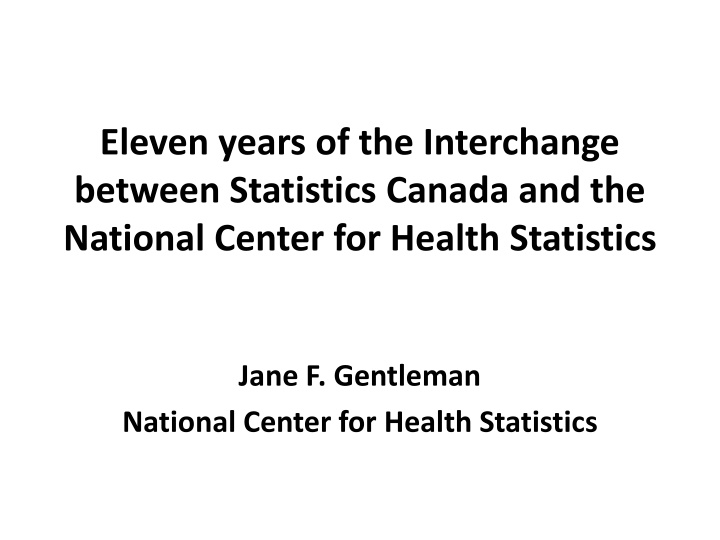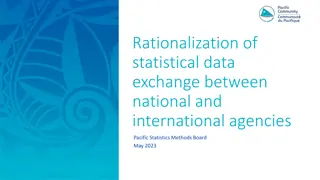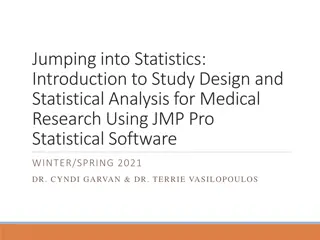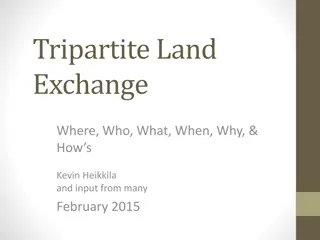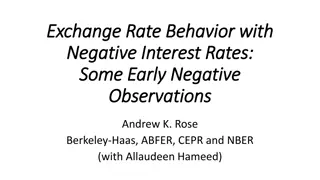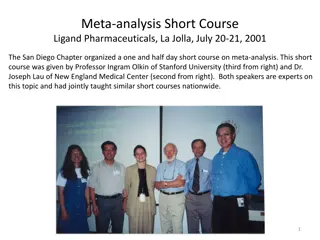Insight into Statistical Exchange: A Comprehensive Overview
Delve into the eleven-year interchange between Statistics Canada and the National Center for Health Statistics, exploring common and unique activities, key figures, and collaborative efforts in statistical research and data policy analysis. Gain a deeper understanding of vital statistics surveys, health interview surveys, and collaborative initiatives aiming to measure functional disability and care needs across cultures.
Download Presentation

Please find below an Image/Link to download the presentation.
The content on the website is provided AS IS for your information and personal use only. It may not be sold, licensed, or shared on other websites without obtaining consent from the author.If you encounter any issues during the download, it is possible that the publisher has removed the file from their server.
You are allowed to download the files provided on this website for personal or commercial use, subject to the condition that they are used lawfully. All files are the property of their respective owners.
The content on the website is provided AS IS for your information and personal use only. It may not be sold, licensed, or shared on other websites without obtaining consent from the author.
E N D
Presentation Transcript
Eleven years of the Interchange between Statistics Canada and the National Center for Health Statistics Jane F. Gentleman National Center for Health Statistics
Some common activities Vital statistics Surveys/censuses of health care providers (with CIHI) National health interview surveys: Natl Population Health Survey (STC) Canadian Community Health Survey (STC) Natl Health Interview Survey (NCHS)
Some NOT common activities Cancer registry (STC only) Long-term longitudinal surveys (STC only) Physical measures (NCHS only, then) Data Users Conference (NCHS only, then)
Manning Feinleib, Director of NCHS: 1983-1995 Ed Sondik, Director of NCHS: 1995-present Ivan Fellegi, Chief Statistician of STC: 1985-2008
Proc. 1988 Intl. Symp. on Data on Aging, Editor: Manning Feinleib Closing remarks by Mary Grace Kovar, Dr.P.H., Special Assistant for Data Policy and Analysis, NCHS: The proposed international collaborative effort is only one of many that will be needed if we are to reach the ultimate goal We need to plan collaborative research I hope that the research is designed to begin the development of a manageable set of questions that can be used in interview surveys to measure the prevalence of functional disability and the need for care from another person
(Quote, continued) I think that we agree that dissimilar questions can measure similar concepts and that similar questions can measure dissimilar concepts. Therefore, we need to develop conceptually similar questions on functional disability and the need for care that can be used in cross-cultural and cross-national population studies [W]e can use the data that we have and design tabulations to make comparisons that we can trust across cultures and nations. I think that Dr. Forbes has shown the way, and we are ready to begin.
1991 presentation re Supplement on Aging Kovar, Mary Grace & William F. Forbes. Risk of Disability in the U.S. and Canada, Symposium on the International Collaborative Effort on Measuring the Health and Health Care of the Aging, Rockville, MD, September 4, 1991.
1995 pub (NCHS Series 5, No. 8) Prevalence of Disability Among Older Persons: United States and Canada Mary Grace Kovar, Dr.P.H., National Opinion Research Center, University of Chicago Julie Dawson Weeks, M.A., Office of Analysis, Epidemiology and Health Promotion, NCHS William F. Forbes, Ph.D., Univ of Waterloo & Canadian Centre for Health Information, STC
There has been a long-term annual Interchange between Statistics Canada & the U.S. Census Bureau 1999: First Interchange between Statistics Canada and NCHS, at NCHS 2010: Now preparing for 12thannual Interchange, at STC
Some Interchange legacies We know each other & interact between Interchanges Technical knowledge exchange Joint research, presentations, publications Canadian Health Measures Survey, MEC, winterization, analytic plan, comparisons STC Health Data Users Conference Joint Canada/United States Survey of Health (JCUSH) (conceived at 2000 Interchange)
1993-4 JCUSH Produced highly comparable estimates: same sample design same questions same time same phone centers (STC ROs) same editing & processing procedures Joint release: microdata & 1stanalysis
JCUSH (cont.) Questions taken from ongoing national health surveys: National Health Interview Survey (NCHS) National Population Health Survey (STC) Canadian Community Health Survey (STC) 4 sets of disability/fcnl limitations questions
A main JCUSH analytic result 3 populations: U.S., without health insurance U.S., with health insurance Canada Last two remarkably similar
Some JCUSH results on obesity BMI = Weight (kg)/[Height(m)]2 Obese: Body Mass Index (BMI) 30
Yank Women Fatter (from the Winnipeg Sun & Edmonton Sun, June 3, 2004) Ottawa When it comes to obesity, American women tip the scales compared with their Canadian sisters, a cross border health study confirms for the first time. Overall, 21% of Americans were obese compared with 15% of Canadians, says the study released yesterday by Statistics Canada and the U.S. National Center for Health Statistics . continued ..
Previous research has suggested obesity may be more prevalent in the United States, but this is the first definitive confirmation, said Diane Finegood, a scientific director of the Canadian Institutes for Health Research (CIHR). Whenever I go down there I think, God, there really is a difference, but this is in fact the first data I m aware of where a survey was done at the same time in Canada and the United States with the same question and the same methodology by the same people, said Finegood.
Distribution of BMI for United States (red) and Canadian (green) women D ensi t y 0. 10 Legend U.S. women 0. 09 Canadian women 0. 08 0. 07 0. 06 0. 05 0. 04 0. 03 0. 02 0. 01 0. 00 0 10 20 30 40 50 60 B M I
Distribution of BMI for United States (blue) & Canadian (black) men D ensi t y 0. 10 Legend U.S. men 0. 09 Canadian men 0. 08 0. 07 0. 06 0. 05 0. 04 0. 03 0. 02 0. 01 0. 00 0 10 20 30 40 50 60 B M I
